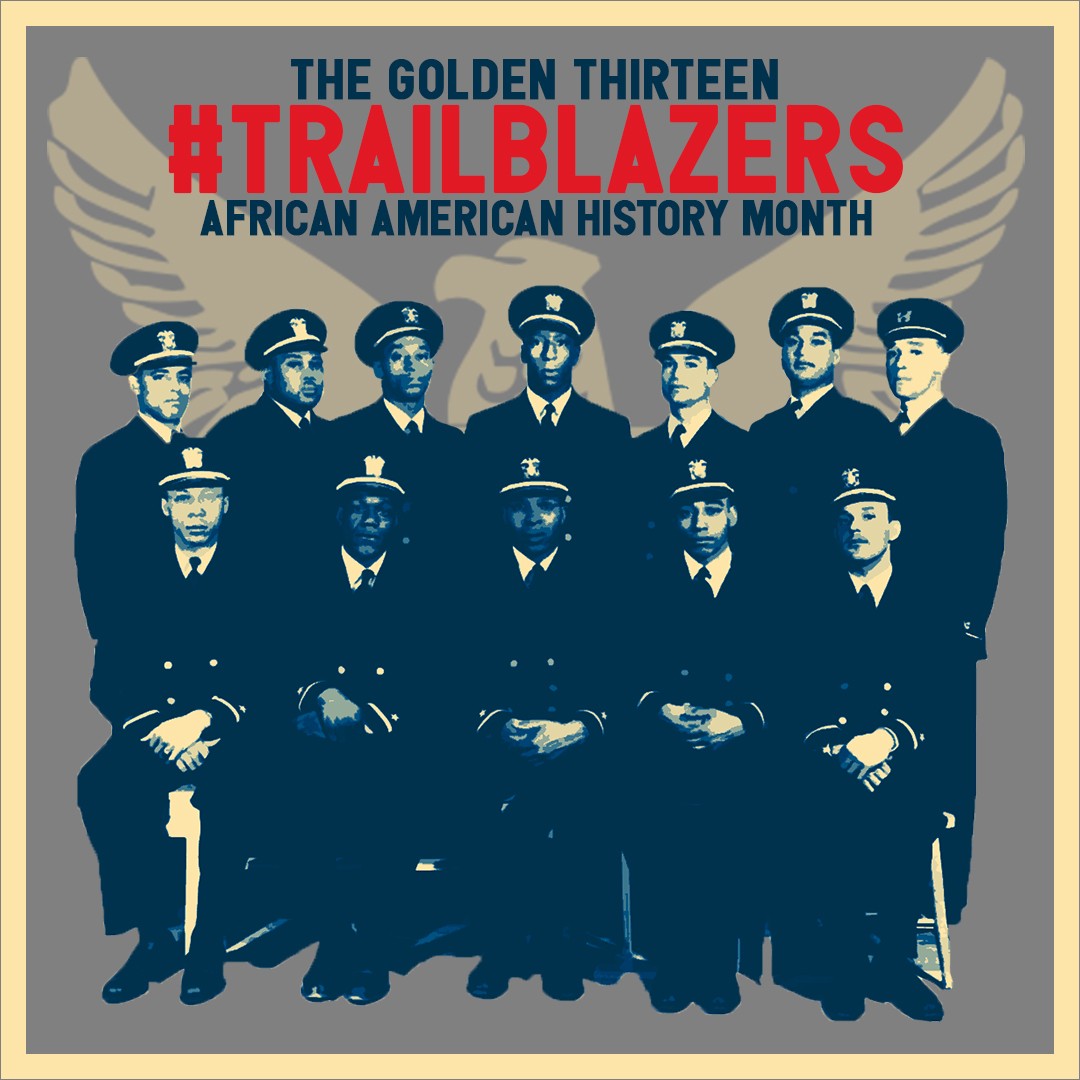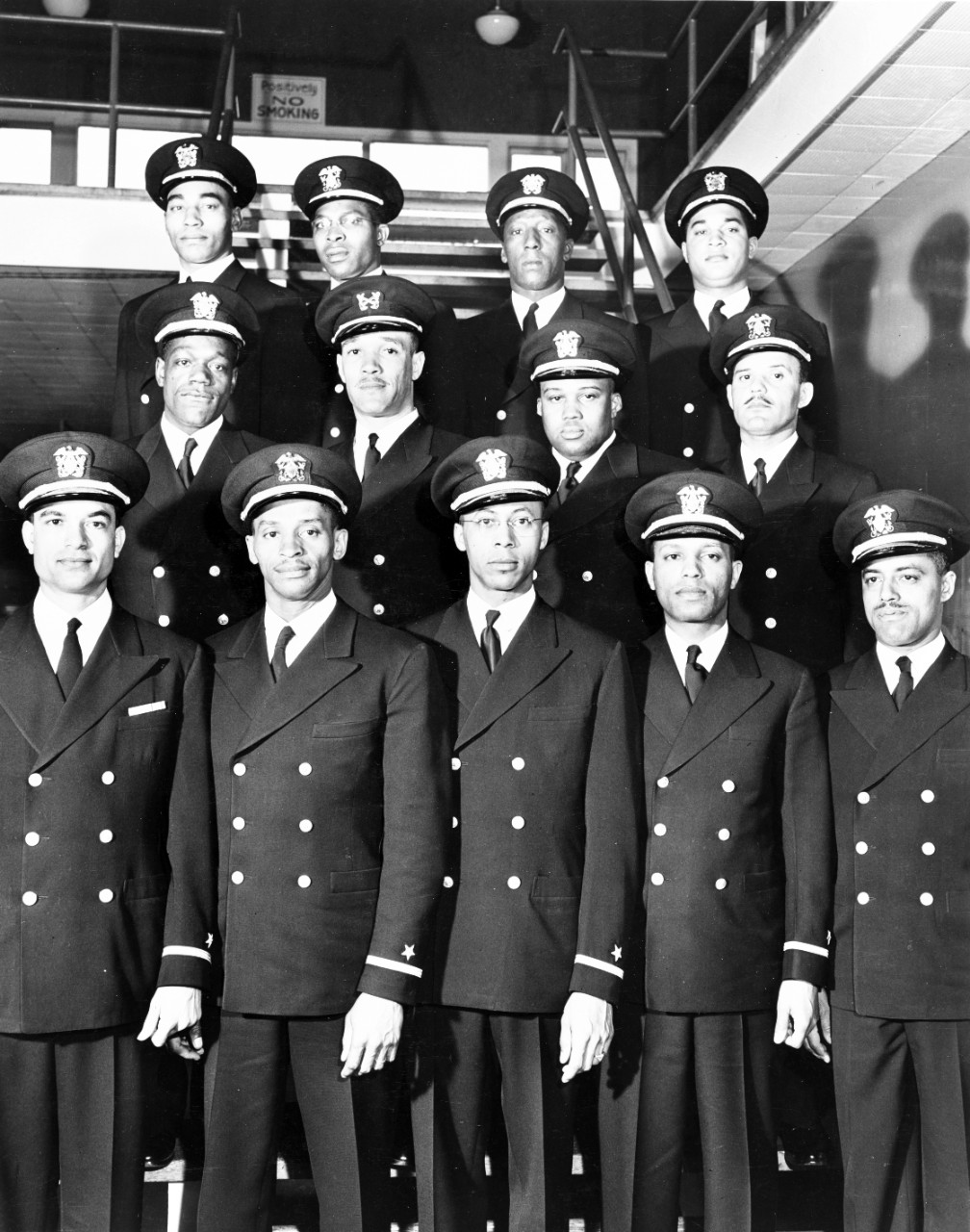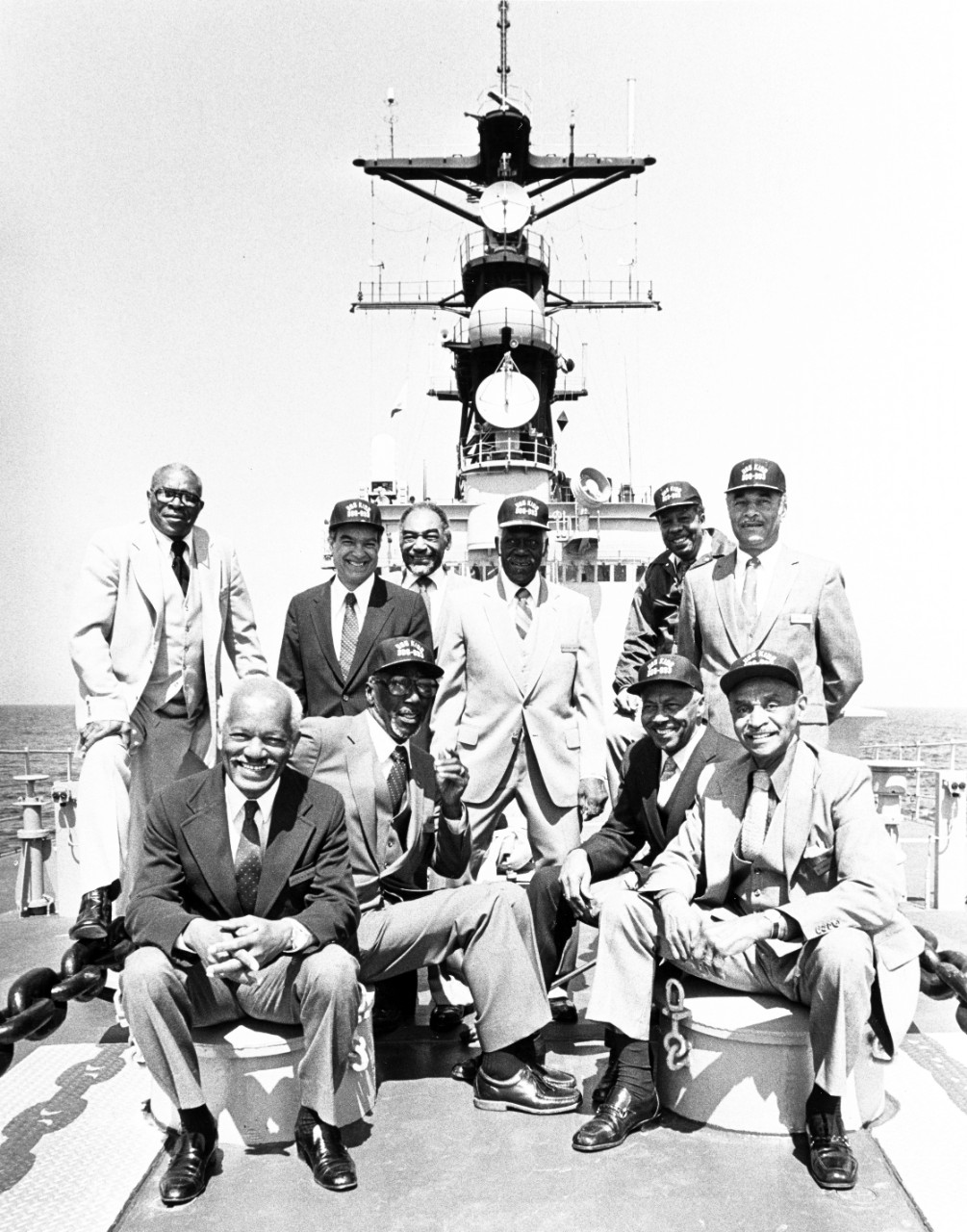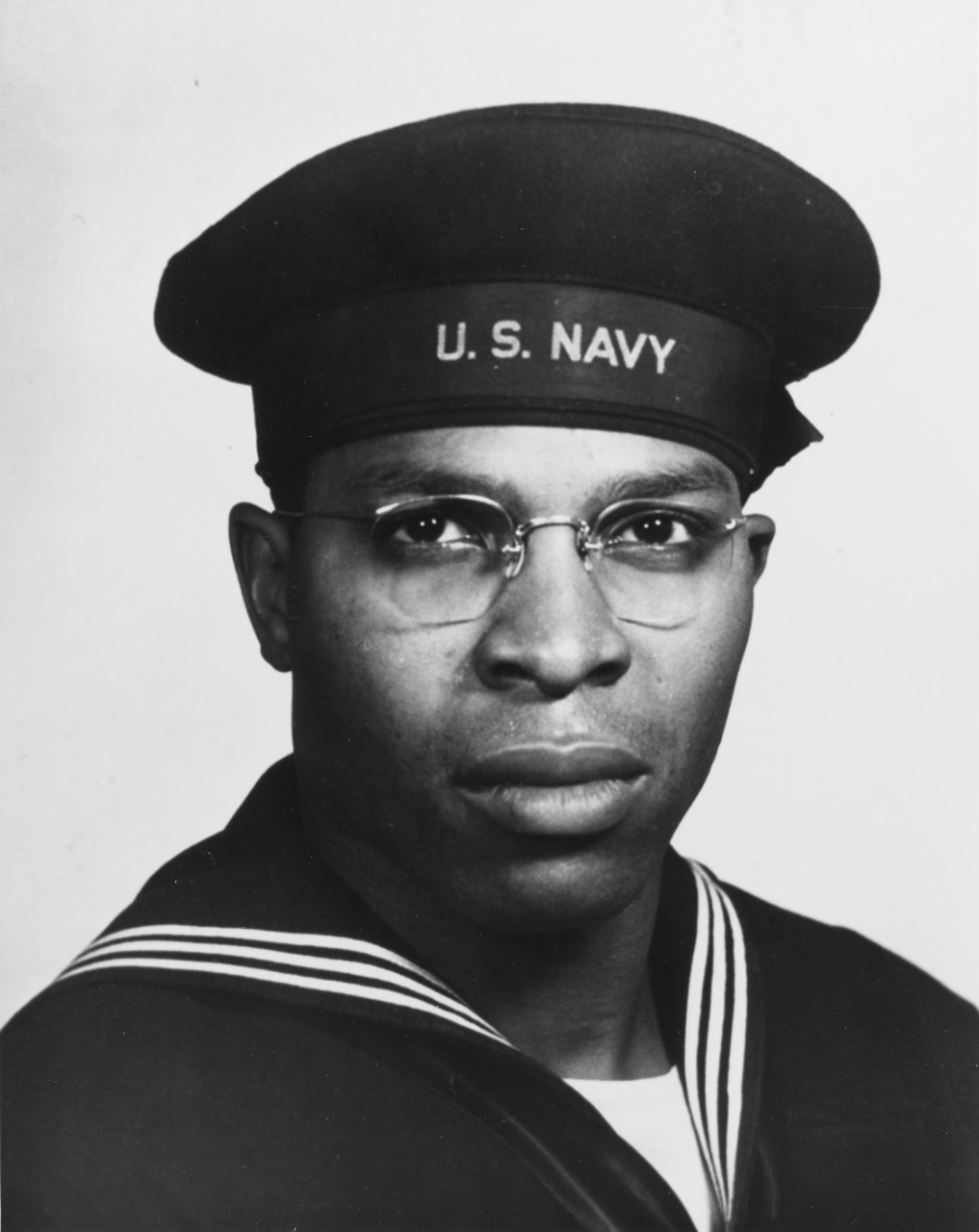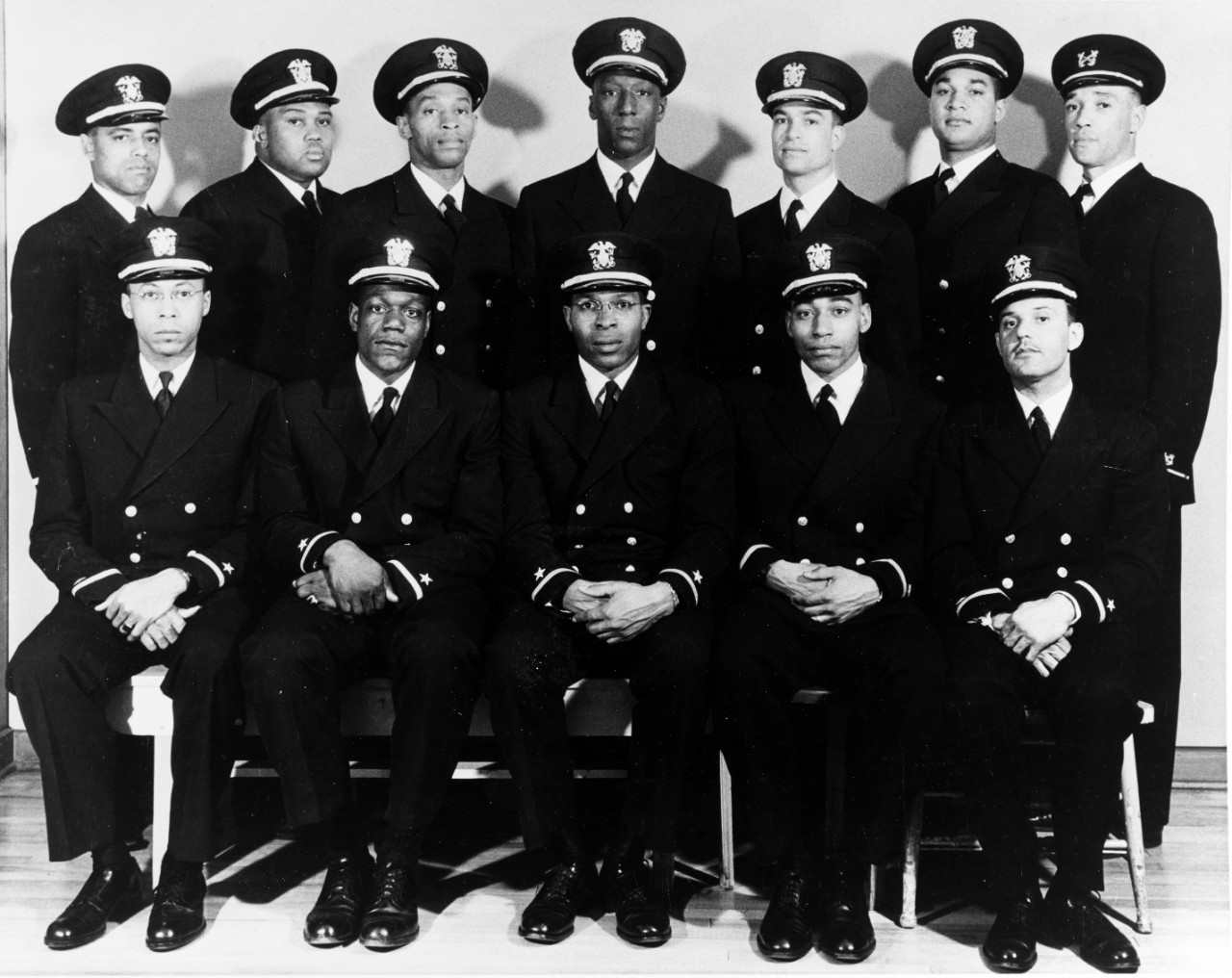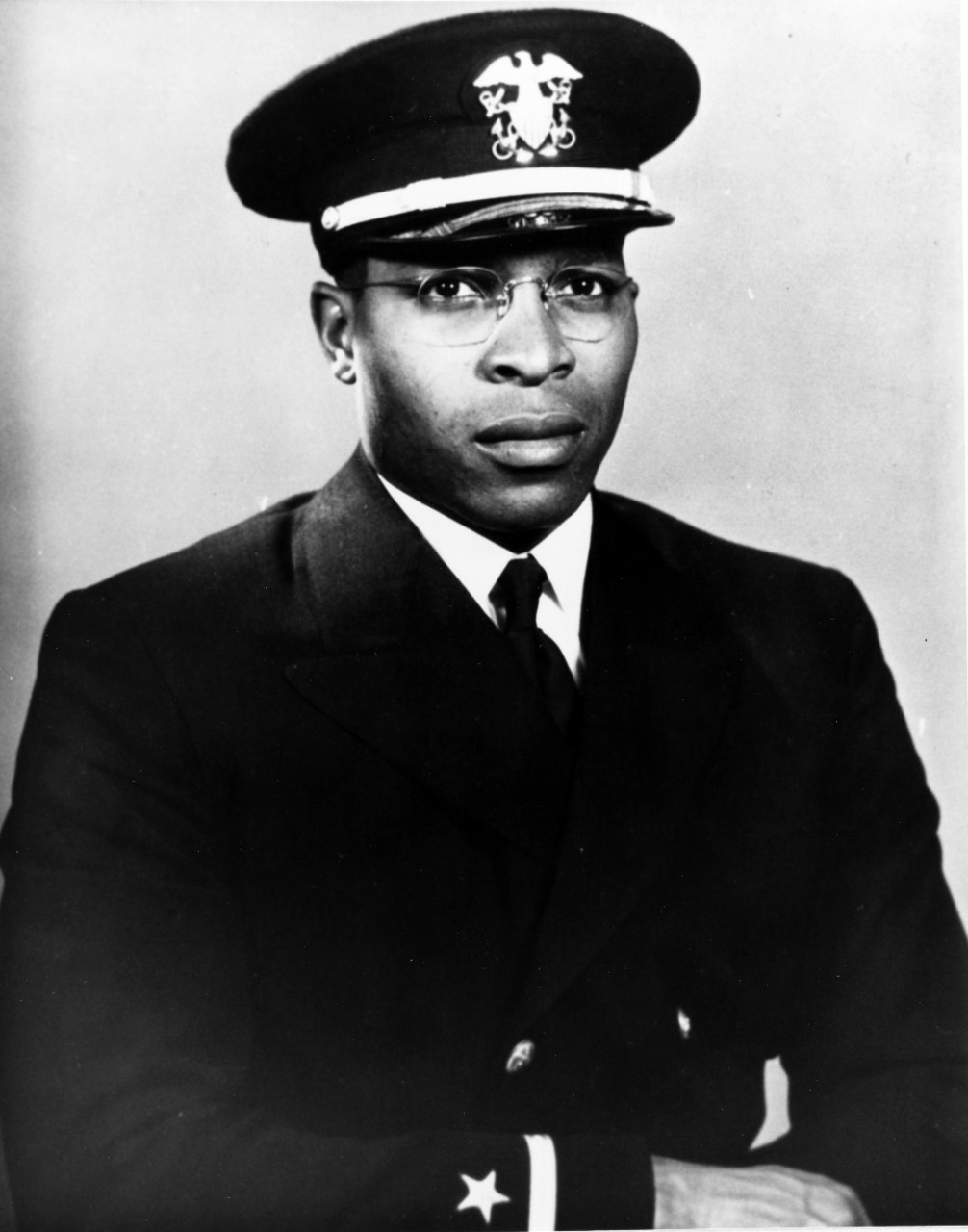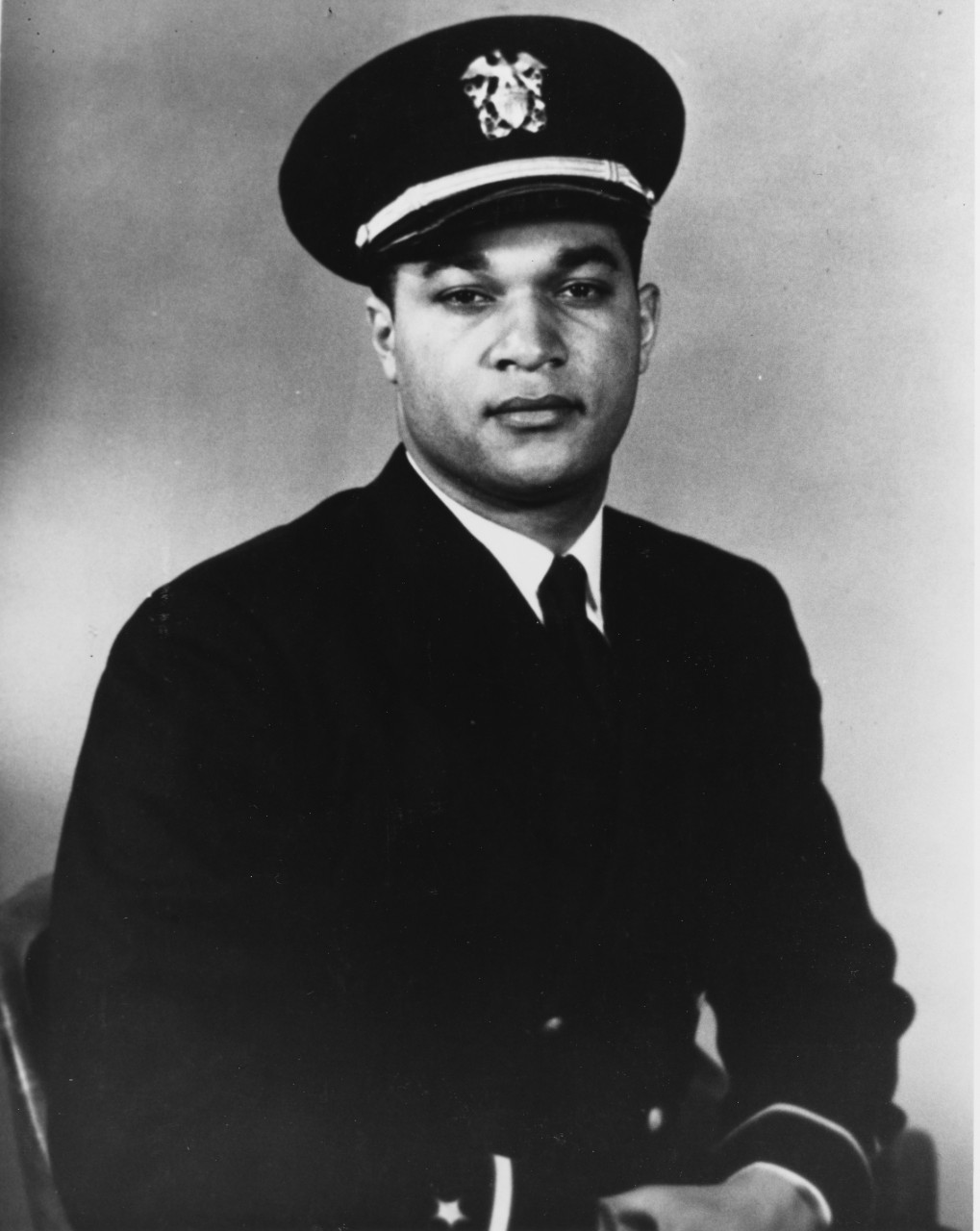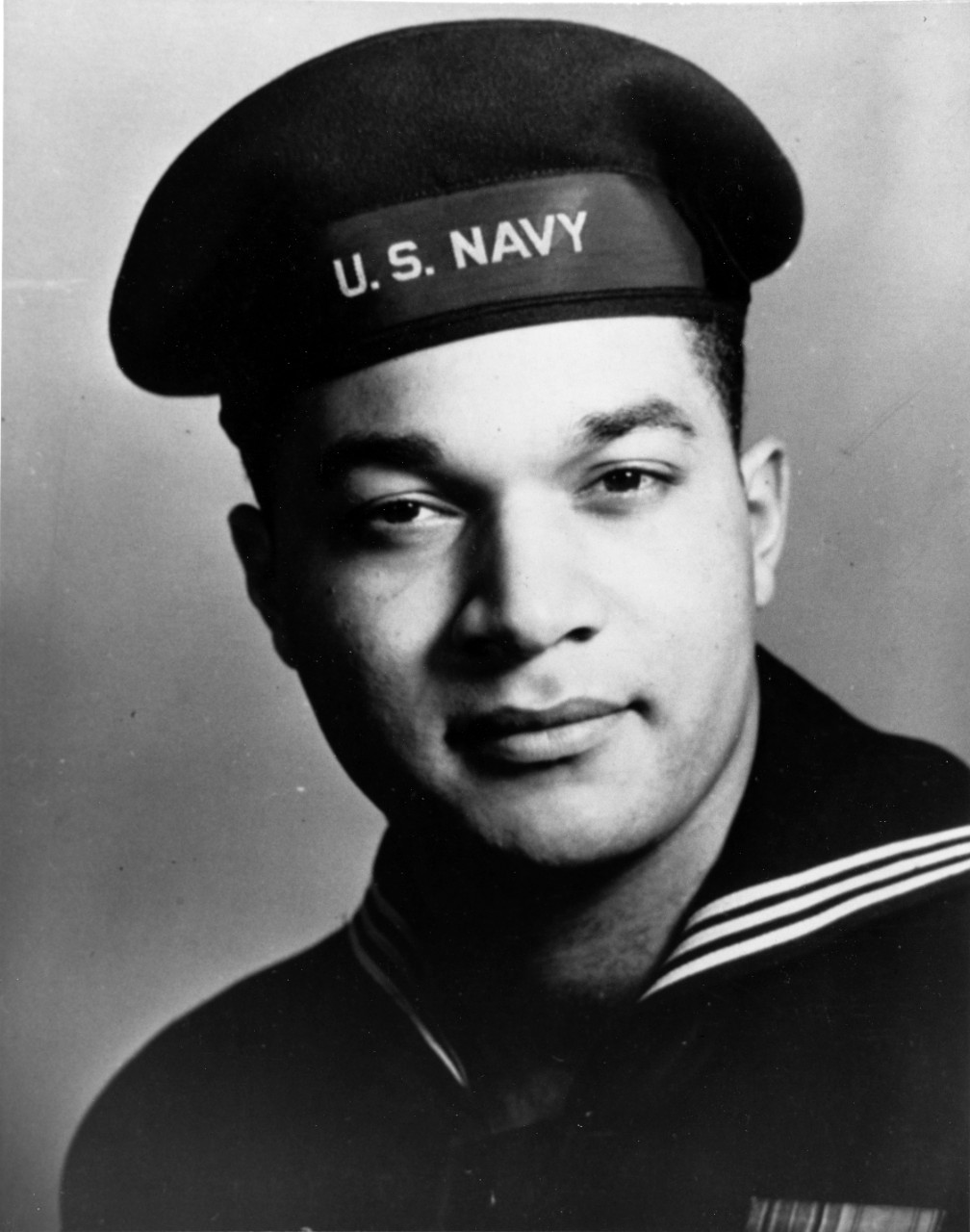The Golden Thirteen
Brief biographies of the members of the first officer training course for African Americans in the U.S. Navy.
In January 1944, there were nearly 100,000 Black Sailors in the United States Navy, but none were officers. That would change when a group of sixteen Black enlisted men were assembled at Recruit Training Center, Great Lakes, in Illinois for officer training that month. The odds were initially stacked against them as there was still a strong sentiment within the Navy that African Americans could not succeed as officers. The normal officer training course was sixteen weeks, however these men were expected to complete it in eight – a move that they believed was an attempt to set them up for failure. The Navy also expected a twenty-five percent attrition rate, similar to that of white officer candidates. However, the group of sixteen were determined not to fail, and supported one another throughout the brutal pace of the training. Though lights out was at 2230 each night, the group placed blankets over their windows and studied together by flashlight, each man bringing his expertise to help strengthen the skills and knowledge of the others. When the course was over, all sixteen passed their exams. In fact, their marks were so outstanding that some in Washington were certain that the men had cheated. When the group was forced to retake certain exams, they scored even higher, with an average grade of 3.89 out of 4–the highest average of any class in Navy history at the time.
Despite the fact all sixteen had passed the course, the Navy still wished to only commission 12, or seventy-five percent, as officers. Twelve were selected, and a thirteenth was made a chief warrant officer, hence the nickname “The Golden Thirteen.” The other three were sent back into the enlisted ranks with no explanations given. Here are brief biographies of all sixteen men.
The Golden Thirteen was comprised of:
Three Sailors successfully completed the training, but were returned to enlisted ranks without explanation:
Jesse Walter Arbor was born in Cotton Plant, Arkansas, on 26 December 1914. He graduated from high school in Cotton Plant, then studied for three years at the Agricultural, Mechanical and Normal College, Pine Bluff, Arkansas. At the time of his enlistment in the U.S. Naval Reserve, he worked as a Pullman porter and was also operating a tailoring shop. Earlier, he had worked as a waiter and doorman in a Chicago (Illinois) hotel. He enlisted in the U.S. Naval Reserve on 11 September 1942 and had advanced to Quartermaster First Class, when he received his appointment as Ensign, USNR, 1 March 1944. He was promoted to Lieutenant (junior grade), to date from 1 August 1945. After receiving his commission in 1944, he reported in June of that year as company supervisor at the U.S. Naval Barracks, Manana, Oahu, Territory of Hawaii. He remained there until February 1945, after which he had duty as division officer/battalion commander at the U.S. Naval Barracks #1, Naval Supply Depot, Guam, Marianas Islands.
Assigned in December 1945 to Headquarters, Ninth Naval District, Great Lakes, Illinois, he continued to serve there until 1 April 1946, when he was released from active duty. He was honorably discharged from the Naval Reserve on 15 October 1954. Following his discharge, he returned to Chicago where he opened a tailor shop. He retired in 1969. Lieutenant (junior grade) Arbor passed away in Chicago on 11 January 2000. Lieutenant (junior grade) Arbor has the American Campaign Medal, Asiatic-Pacific Campaign Medal, and the World War II Victory Medal.
Phillip George Barnes was born in Washington, D.C. on 17 March 1909. After graduation from Washington’s Armstrong High School in 1927, he attended the U.S. School for Printers and later worked as a bookbinder at the Government Printing Office. He enlisted in the U.S. Army Reserve on 19 February 1931 to serve with the 428th Infantry. With the expiration of that enlistment on 18 February 1934, he received his honorable discharge. After the U.S. entered World War II, Barnes enlisted as an apprentice seaman in the U.S. Naval Reserve on 9 December 1942. He merited promotion in rate as follows: fireman third class, March 1943; shipfitter third class, August 1943; coxswain, November 1943; and boatswain mate first class in January 1944. Selected for officer training, Barnes commissioned as an ensign in the U.S. Naval Reserve on 1 March 1944. After commissioning, he underwent further training at Naval Reserve Training Station, Great Lakes, Illinois, until July 1944, when he received an assignment to USS Migrant (IX‑66). Detached from that vessel in February 1945, he trained at the Naval Ammunition Depot, Hingham, Massachusetts, before assignment to the Naval Ammunition Depot, Fort Mifflin, PA (April-July 1945). Advanced to lieutenant (junior grade), effective 1 August 1945, he was assigned to U.S. Naval Base, Saipan, Marianas Islands. He remained there until ordered to return to the United States in January 1946 for separation processing. Released from active duty on 28 February 1946, Barnes died at the U.S. Naval Hospital, Bethesda, MD, on 2 March 1949. For his service, Lieutenant (junior grade) Barnes received the American Campaign Medal, Asiatic-Pacific Campaign Medal, and the World War II Victory Medal.
Born in Oberlin, Ohio, on 25 January 1915, Samuel Edward Barnes attended Oberlin High School and matriculated to Oberlin College, where he received a Bachelor of Arts in 1939. [1] An avid athlete, he played football and raced track, both in high school and college. Following college graduation, he worked in a variety of physical education jobs in Ohio and North Carolina. His last position prior to enlisting in the U.S. Naval Reserve in October 1942 was assistant physical education director at North Carolina State College, in Durham.
In the Naval Reserve, Barnes served as an enlisted athletic specialist, rising to the rank of specialist first class C (the equivalent of a first class petty officer), before attending officer candidate training and being commissioned as an ensign in the U.S. Naval Reserve on 24 February 1944. After commissioning, he ran athletic programs at the Naval Training Center, Great Lakes, Illinois, until May 1945. Despite being a valued member of the base community, neither Barnes nor any other Golden Thirteen member was permitted to enter the officers’ club because of their race. From May-September 1945, Barnes worked at the Naval Training and Distribution Center, Camp Peary, Williamsburg, Virginia, before shipping off to the Pacific to serve as division officer of Logistic Support Company #64. This all-Black stevedore unit performed menial work unloading ships in Okinawa and elsewhere in the Pacific—a typical assignment for Black Sailors during World War II and one that underscored the institutional racism of era (more Black Sailors were killed working as stevedores than in combat). Barnes left active duty service in October 1946 as a lieutenant (junior grade) and was honorably discharged in 1954. After the war, he earned a doctorate in physical education from Ohio State University. In 1947, he became a faculty member at Howard University, where he taught physical education, and coached various teams. From 1956 to 1970, he was the athletic director at Howard. He also served on the executive committee of the National Collegiate Athletic Association, the first black person to hold a place on that board. He died in Washington, D.C., on 21 January 1997.
Dalton Louis Baugh was born in Crossett, Ashley County, Arkansas, on 23 June 1912, the son of John and Pearl Baugh. In 1942, Baugh graduated from Arkansas State College at Pine Bluff with a bachelor’s degree in engineering. That same year, on 21 September 1942, he enlisted in the U.S. Naval Reserve at Little Rock, Arkansas. In 1944, after several years of service as a motor machinist’s mate, he became one of the first thirteen African American Sailors in the U.S. Navy to be selected for officer candidate school. Upon graduation he was commissioned ensign on 24 February 1944. Ensign Baugh went on to serve as the chief engineering officer of USS Migrant (IX-66), taught at the Navy Engineering School in Hampton, Virginia, and served as the operations officer for a Logistics Support Company at Port Hueneme, California. He was released from active duty service on 25 November 1945, but continued to serve in the Naval Reserve until his retirement as a lieutenant commander on 1 July 1964. In addition to his years of service in the reserves, Baugh earned a master’s degree in mechanical engineering at the Massachusetts Institute of Technology (MIT), Cambridge, Massachusetts, and then served as an instructor of fluid engineering at MIT’s gas turbine laboratory. He also later worked as a planner for the Massachusetts Department of Public Health and formed his own architectural engineering firm. Baugh died at the age of 72, in Boston, Massachusetts, on 1 January 1985, and was buried at Mount Auburn Cemetery in Cambridge. He was survived by his wife, Ethel L. (Middleton) Baugh and two sons Dalton L. Jr., and Joseph D. Baugh.
George Clinton Cooper was born in Washington, Beaufort County, North Carolina, on 7 September 1916, the son of James Edward Cooper and Laura Jane (Johnson) Cooper. He did his undergraduate work at Hampton Institute in Hampton, Virginia, where he met his wife Margarett Gillespie. In 1940, he took a job as a sheet-metal instructor at the National Youth Administration, housed at Wilberforce University in Ohio, but returned to Hampton after the outbreak of the war to teach metalsmiths at the Class A naval training school there. On 21 June 1943, Cooper enlisted in the Navy, receiving a direct appointment as a chief petty officer. He continued teaching in Hampton until ordered to the Recruit Training Center, Great Lakes Illinois, where he entered an officer training course, and was commissioned as an ensign on 24 February 1944. Because his off-the-rack uniform needed no alterations, he became the first African-American to wear a naval officer’s uniform. Following his commissioning, he returned to Hampton as a personnel officer and training supervisor, before receiving orders to the Pacific in 1945. Undergoing a routine medical exam in Norfolk in advance of his deployment, doctors discovered a back injury sustained during officer’s training that precluded him from serving. He was given a medical discharge and released from the Navy in 1945. Earning a master’s degree from Columbia University in 1948, Cooper continued on as an educator, working again at Wilberforce University as well as Antioch College. In 1969, he became the first African American Director of Human Resources for the city of Dayton, Ohio, serving in that job until his retirement in 1981. He continued to work, however, as a concessionaire at the Dayton International Airport, creating a successful business with multiple storefronts. In failing health, George Clinton Cooper passed away on 21 May 2002.
Reginald Ernest Goodwin was born in Washington, D.C., on 27 June 1907. An alumnus of Dunbar High School and Howard University, he was employed by the Children’s Aid Society of New York (1930-1940), where he served as physical director and club worker (1930-1933) before becoming director of the Boys Division in the Harlem Children's Center. Moving to Cincinnati, Ohio, he served as director of the Boys Club of Cincinnati until his enlistment in the United States Naval Reserve on 27 July 1942. He underwent basic training at Naval Training Station, Great Lakes, Illinois, and advanced to seaman second class on 25 September 1942. His progression included yeoman third class, 11 November 1942 (rating changed to specialist third class on 21 December 1943) and to specialist first class (physical instructor), 3 January 1944. Selected for officer training, Goodwin received his commission as an ensign, USNR, on 24 February 1944. After receiving his commission, he underwent further instruction at the Naval Training Center, Great Lakes, until February 1945. Afterward he continued serving at the Recruit Training Command. Promoted to lieutenant (junior grade), as of 1 July 1945, he was eventually assigned to the U.S. Naval Base, Saipan, Marianas Islands. He remained there until ordered early in 1946 to return to the United States for separation processing.
After his return, he was released from active duty on 13 March 1946. After continuing in the Naval Reserve, he received his honorable discharge on 15 October 1954. Goodwin attended law school and later founded the law firm of Goodwin and Campbell in Chicago, Illinois, before retiring to Scottsdale, Arizona, in 1973. Goodwin returned to Chicago for a speaking engagement at the Frogs Club (an African-American leadership group), but collapsed as he left the lectern and died of an apparent heart attack on 2 November 1974. For his service, Lieutenant (junior grade) Goodwin received the American Campaign Medal, Asiatic-Pacific Campaign Medal, and the World War II Victory Medal.
James Edward Hair was born in Blackville, Barnwell County, South Carolina, on 5 August 1915, the son of Alfred and Rosa F. (Nix) Hair. At a young age Hair’s father, a Baptist minister, moved the family to Fort Pierce, Florida. In 1938, he graduated from a two-year program at Bethune-Cookman College in Daytona Beach, Florida, and then a short time later, earned a bachelor’s degree at Xavier University in New Orleans, Louisiana. With his studies completed, Hair enlisted in the U.S. Naval Reserve on 1 July 1942, and attended the Navy’s quartermaster school. In 1944, he became one of the first 16 Black Sailors in the U.S. Navy to be selected for officer candidate school and upon graduation he was commissioned ensign on 24 February 1944. Ensign Hair went on to command the large harbor tug USS Cahto (YTB-215), serving the East Coast’s Third Naval District. In 1945, he was promoted to the rank of lieutenant (junior grade) and in March, he joined the crew of the escort ship Mason (DE-529). Mason was one of only two U.S. warships in World War II that was manned by predominantly African American crews. Afterwards, Lieutenant (junior grade) Hair served as the first lieutenant on board the landing ship tank LST-1026, which operated in the Far East until mid-July 1946. That same year on 11 November 1946, he left the active duty service. Upon his return to the private sector, Hair earned a master’s degree in social work at Fordham University, New York, and then worked as a case worker, primarily in New York City, for the next 31 years. He died on 3 January 1992, at the age of 76, and was subsequently buried at the Calverton National Cemetery, Calverton, New York. He was survived by two sons and his ex-wife Mary Hall.
Charles Byrd Lear was born in Keokuk, Iowa, on 2 July 1916, the son of Cole A. and Naomi (Mills) Lear. He attended Keokuk High School, and prior to enlisting in the Naval Reserve, was a farmer and also operated a coal business in Canton, Missouri. On 29 June 1942, he enlisted as an apprentice seaman in the U.S. Naval Reserve in St. Louis, Missouri, and received his recruit training at the Naval Training Station, Great Lake, Illinois, receiving advancement to seaman second class (19 September 1942) and coxswain (1 March 1943), before being appointed boatswain (24 February 1944). After further training at Great Lakes, Lear served as Administrative Assistant and Company Supervisor at the Naval Barracks, Manana, Oahu, Territory of Hawaii (June 1944-February 1945), before he served as officer in charge, Hill Camp Fuel Dump No. 21, Naval Supply Depot, Guam, Marianas Islands, during which tour he received appointment to chief boatswain (1 July 1945). Returning to the United States, he was attached to the Ninth Naval District, headquartered at Great Lakes, Illinois, from December 1945 until February 1946, then reported as executive officer of the Harlem (New York) Sub-Station of the Naval Shore Patrol, Third Naval District. Detached in August 1946, he was released from active duty on 9 September 1946. Lear, who received the American Campaign, Asiatic-Pacific, and World War II Victory Medals, died on 28 October 1946 at Lake Forest, Illinois.
Graham E. Martin was born in Tobacco City, Tennessee, on 18 January 1919. After earning a bachelor of arts in history from Indiana University and a master of arts degree from Howard University, Martin enlisted in the U.S. Naval Reserve on 31 July 1942. He was commissioned an ensign in the USNR on 1 March 1944. In July, he was assigned to the staff of Commander, Naval Local Defense Forces, Twelfth Naval District, in San Francisco, California. In that role, Martin served on board the yard patrol craft YP-131. A year later, Martin was assigned to Service Force, Pacific Fleet. The Navy promoted Martin to lieutenant (junior grade) on 1 August 1945, and subsequently assigned him to Logistics Support Company No. 515 on Eniwetok Atoll, Marshall Islands. After the war, he briefly served at Headquarters, Eleventh Naval District, in San Diego before transferring to Headquarters Ninth Naval District in Great Lakes, Illinois, in January 1946. He remained there until released from active duty on 27 June. Shortly after his release from active duty, Martin and his wife Alma moved to Bluefield, West Virginia, where he taught and coached football for a year. In 1947, the couple returned to Indianapolis and Martin began teaching and coaching at his alma mater, Crispus Attucks High School. Twelve years later, Martin was honorably discharged from the USNR on 21 April 1959. He remained at Crispus Attucks until his retirement in 1982. Still a resident of Indianapolis, Martin passed away on 9 May 2006.
Dennis Denmark Nelson was born in Washington, D.C. on 3 November 1907 to Dennis D. Nelson, Sr. and Florence Nelson and earned a bachelor of science degree in chemistry from Fisk University in 1930. Nelson pursued graduate education in sociology at several institutions, including Howard and Vanderbilt Universities and education at Miner Teachers College. He worked as field executive for Boy Scouts of America from 1930 to 1935 and the U.S. Department of Labor and District of Columbia Government from 1937 to 1940 before returning to Fisk University as a member of the Department of Social Sciences staff prior to U.S. entry into World War II. On 5 June 1942, Nelson enlisted in the Naval Reserve and served at Naval Recruiting Station, Nashville, Tennessee, before being commissioned an ensign on 9 March 1944 at Naval Training Center, Great Lakes, Illinois, where he was officer-in-charge, special training unit until May 1945. In October 1947, then-Lieutenant Nelson assumed temporary duty in the Press Section, Division of Public Information, and continued to work in public affairs until his retirement from the Navy on 1 July 1963.
In July 1948 President Truman issued Executive Order 9981, which abolished discrimination in the Armed Forces “on the basis of race, color, religion, or national origin” and eventually led to the end of segregation in the military services. Three months prior, Nelson submitted a report entitled The Integration of the Negro into the U.S. Navy that eventually was published as a book in 1951. After attaining the rank of lieutenant commander in June 1953, Nelson went on to serve as public information officer at Naval Training Center, San Diego, from December 1963; at Headquarters, Third District, from March 1956; and Armed Forces Radio and Television Service from July 1959. Lieutenant Commander Nelson earned the Armed Forces Campaign Medal, Asiatic-Pacific Campaign Medal, the World War II Victory Medal, and the National Defense Service Medal. He married the former Evangeline Steward with whom he had two sons and a daughter. He passed away on 3 April 1979.
John Walter Reagan, born on 5 March 1920 at Marshall, Texas, enlisted in the USNR on 3 July 1942, and was trained as an electrician’s mate at the Hampton (Virginia) Institute, being advanced to electrician’s mate first class. Receiving his commission as ensign, USNR (24 February 1944), Reagan got further instruction at the Naval Training Center, Great Lakes, Illinois, then commanded the Naval Training Station, Hampton Institute (April-June 1944), after which he served as officer-in-charge of various big harbor tugs (YTB) attached to the Naval Frontier Base, Tompkinsville, New York. He became division officer of Logistic Support Company 69, Advanced Base Supply Training Command, Camp Peary, Willamsburg, Virginia, in June 1945. Then, having been promoted to lieutenant (junior grade), USNR, on 1 July 1945, he deployed to the Naval Supply Base, Okinawa, with that company where he served as the unit’s operations and division officer (August-November 1945), then served as the base’s welfare and recreation officer (November 1945) before returning to the United States. He was released from active duty on 22 February 1946. Ordered to active duty over three years later, Lieutenant (junior grade) Reagan served as Naval Reserve Recruiting Officer and Assistant to the Officer in Charge of Recruiting, Naval Recruiting Station and Office of Naval Officer Procurement, New York, New York (October 1949-July 1953), during that tour receiving promotion to lieutenant, USNR, on 1 April 1950. After training with the rear echelon of Naval Beach Group ONE at the Naval Amphibious Base, San Diego, California, he deployed to Korean waters as Boat Company Commander, Boat Unit ONE (August 1953-January 1954), after which he returned to the United States where he was released from active duty on 21 January 1954. Later that year, Reagan again served a tour of active duty, this time as recruiting officer, Naval Recruiting Station and Office of Naval Officer Procurement, New York (October-November 1954), at the end of which period he was promoted to lieutenant commander, USNR, for temporary service on 1 November 1954. On 31 January 1958, Reagan received promotion to lieutenant commander, USNR, to date from 1 November 1954. Recipient of the Naval Reserve, American Campaign, Asiatic-Pacific Campaign, World War II Victory, National Defense Service, Korean Service, and United Nations Service Medals, Lieutenant Commander Reagan died on 31 August 1994 at Encinitas, California.
Reagan’s son, John Walter Reagan, Jr., born on 25 March 1946, enlisted in the U.S. Marine Corps, and was killed in action on 22 July 1966 in Quang Tri Province, South Vietnam, while serving as a corporal in I Company, Third Battalion, Fifth Marines, First Marine Division, III Marine Amphibious Force.
Frank Ellis Sublett was born in Murfreesboro, Rutherford County, Tennessee, on 5 March 1920, the son of Frank E. Sublett, Sr., and Rosa L. (Fugett) Sublett. At an early age, Sublett’s family moved to Illinois, where he attended grade school. He later went on to complete three years of college, beginning his studies at the University of Wisconsin at Madison, and then transferring to George Williams College, Chicago, Illinois. Sublett enlisted in the U.S. Naval Reserve on 7 July 1942, and was trained as a motor machinist’s mate. In 1944, after serving in a navy machine shop for several years, he became one of the first thirteen African American Sailors in the U.S. Navy to be selected for officer candidate school. Upon graduation he was commissioned ensign on 24 February 1944. Ensign Sublett then served with the Naval Local Defense Forces in the Twelfth Naval District, San Francisco, California, as well as with the Port Director’s Office in that District. On 1 July 1945, he was promoted to the rank of lieutenant (junior grade) and briefly deployed as the executive officer of a stevedore battalion at Naval Operating Base, Eniwetok Island, Marshalls. Lieutenant (junior grade) Sublett was released from active duty military service on 11 February 1946, but remained a member of the U.S. Naval Reserve until his honorable discharge on 27 October 1952. After leaving the service, Sublett worked for several years as a service manager for a Buick dealership in the Chicago Metro area and then later became a professional model. The oldest surviving member of the “Golden Thirteen,” Sublett died at the age of 86 and was buried at Saint Joseph’s Catholic Cemetery, Holcombe, Chippewa County, Wisconsin. He was survived by his wife, Susan Sublett.
William Sylvester White was born in Chicago, Illinois, on 27 July 1914. He graduated from Hyde Park High School, Chicago, and then attended the University of Chicago, where he received a bachelor of arts degree in 1935 and doctor of laws in 1937. After graduation, he worked in a private law practice until 1939, when he became a federal prosecutor. In October 1943, he joined the U.S. Naval Reserve and after recruit training followed by an officer training course at the Great Lakes Naval Training Center, was commissioned as a reserve ensign in February 1944. One of the ways the Golden Thirteen overcame systemic racism and earned their commissions was by working together as a team. Upon learning that their officer candidate course had been reduced from sixteen to eight weeks, the group took it upon themselves to study and tutor each other after lights out in their barracks. William Sylvester White, a former assistant U.S. attorney for the Northern District of Illinois, drilled the group on Navy regulations.
Based on his efforts and those with different skill sets, the group scored well above average on final exams. Thereafter, he served as a public information officer at Great Lakes and at the Navy Office of Public Information, in Washington, D.C. Promoted to lieutenant (junior grade) in 1945, he was released from active duty in April 1946, and later received an honorable discharge in 1956. In 1947, White wrote to Wesley Brown, the first African-American to graduate from the Naval Academy, that he “strove for a standard of conduct and performance” every day he wore the uniform, so as not to “prejudice the chances of the Negro we hoped the Academy would one day graduate.” After leaving naval service, White continued to distinguish himself as a federal prosecutor, a judge with the Cook County Circuit Court, and a justice with the Illinois Appellate Court. As a county judge, he pioneered programs for juveniles that would divert nonviolent offenders from custodial care into programs that didn’t require children to be kept in detention. He died in Hyde Park on 20 February 2004.
___________________
Note: Three other Sailors were part of the initial class of sixteen. Because the Navy had assumed a 25% attrition rate, only twelve officer commissions were anticipated. However, the class had a 100% passing rate. Twelve ensigns were commissioned on 24 February 1944, along with one warrant officer. The other three members of the class were returned to the enlisted corps, with no reasons given.
Augustus Alves had been a merchant mariner before the war, and as part of the class of 16 candidates, had passed the exam. No reason was given for Alves not receiving a commission. However, according to oral histories conducted with members of the Golden Thirteen, Alves became the first African American chief specialist in the Naval Reserve and adjutant of the Twenty-Ninth Battalion at Camp Robert Smalls, Great Lakes Training Center, Illinois.
According to oral histories conducted with members of the Golden Thirteen, Pinkney had worked in the labor movement in Atlanta before the war. Despite passing his exams, Pinkney was among the three not chosen to receive a commission.
Williams earned the nickname “Mummy” as a child, after a grammar school book report he had done on King Tut. Williams attended the University of Chicago, and was a union organizer for railroad redcaps before the war. He was among the first black yeomen in the Navy, and was chosen to be in the inaugural class of sixteen officers. Despite passing his exams, Williams was among the three not chosen to receive a commission. Post-war, Williams engaged in social work.
[1] The Naval Institute Barnes biography says he graduated in 1936 but his official Navy biography says 1939.
Prepared by: Mr. Robert Cressman, Fleet History Support Team; Mr. Jeremiah Foster, Fleet History Support Team; Mr. Chris Havern, Fleet History Support Team; Dr. Anna Holloway, Fleet History Support Team; Mr. Kevin Hurst, Fleet History Support Team; Mr. Chris Martin, Fleet History Support Team; Dr. John Sherwood, Fleet History Support Team
The Golden Thirteen, the first African-American U.S. Navy Officers. Photographed 17 March 1944. They are (bottom row, left to right): Ensign James E. Hare, USNR; Ensign Samuel E. Barnes, USNR; Ensign George C. Cooper, USNR; Ensign William S. White, USNR; Ensign Dennis D. Nelson, USNR; (middle row, left to right): Ensign Graham E. Martin, USNR; Warrant Officer Charles B. Lear, USNR; Ensign Phillip G. Barnes, USNR; Ensign Reginald E. Goodwin, USNR; (top row, left to right): Ensign John W. Reagan, USNR; Ensign Jesse W. Arbor, USNR; Ensign Dalton L. Baugh, USNR; Ensign Frank E. Sublett, USNR. Courtesy of Surface Warfare Magazine, 1982. U.S. Naval History and Heritage Command Photograph. (NH 95624)
On board USS Kidd (DDG-993) in April 1982. They are (seated, left to right): Jesse W. Arbor; Dalton L. Baugh; William S. White; Samuel E. Barnes; (standing, left to right): George C. Cooper; James E. Hare; John W. Reagan; Graham E. Martin; Wesley A. Brown; Frank E. Sublett. Brown was the first African-American graduate of the U.S. Naval Academy. The others were members of the Golden Thirteen, the first African-American Navy officers, who were commissioned in 1944. Courtesy of Surface Warfare Magazine, 1982. U.S. Naval History and Heritage Command Photograph. (NH 95625)
Jesse W. Arbor, photographed in U.S. Navy enlisted uniform, probably during his initial training. Photograph is dated 17 March 1944, but was probably taken earlier. He was one of the Navy's first group of African-American officers. Official U.S. Navy Photograph, now in the collections of the National Archives. (80-G-300192)
Photographed in February 1944, soon after attaining officer rank in the Naval Reserve. They are (seated in front row, left-to-right): Ensign George C. Cooper, USNR; Ensign Graham E. Martin, USNR; Ensign Jesse W. Arbor, USNR; Ensign John W. Reagan, USNR; Ensign Reginald E. Goodwin, USNR; (standing in back row, left-to-right): Ensign Dennis D. Nelson, USNR; Ensign Phillip G. Barnes, USNR; Ensign Samuel E. Barnes, USNR; Ensign Dalton L. Baugh, USNR; Ensign James E. Hare, USNR; Ensign Frank E. Sublett, USNR; Warrant Boatswain Charles B. Lear, USNR. Official U.S. Navy Photograph, now in the collections of the National Archives. (80-G-300215)
Frank E. Sublett, photographed in U.S. Navy enlisted uniform, probably during his initial training. Photograph is dated 17 March 1944, but was probably taken earlier. He was one of the Navy's first group of African-American officers. Official U.S. Navy Photograph, now in the collections of the National Archives. (80-G-300212)

